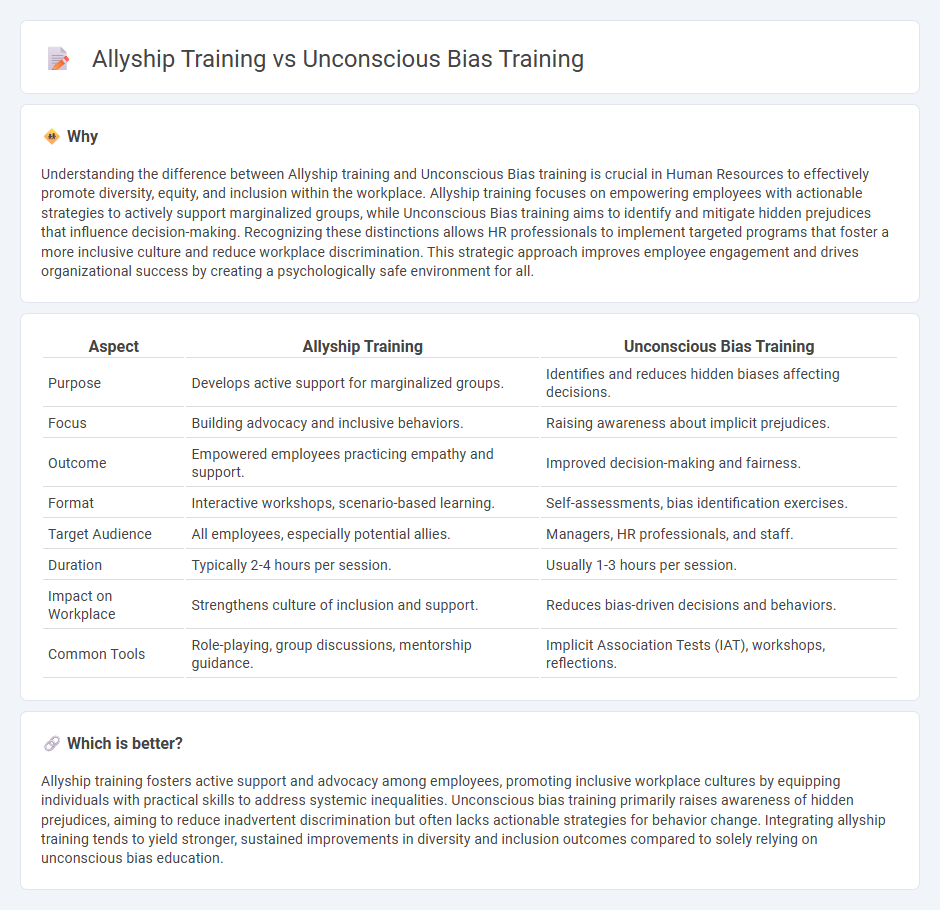
Allyship training empowers employees to actively support marginalized groups and foster inclusive workplace cultures, emphasizing proactive behaviors and advocacy. Unconscious bias training focuses on identifying and mitigating hidden prejudices that influence decision-making and interpersonal interactions. Explore how combining these approaches can enhance diversity, equity, and inclusion in your organization.
Why it is important
Understanding the difference between Allyship training and Unconscious Bias training is crucial in Human Resources to effectively promote diversity, equity, and inclusion within the workplace. Allyship training focuses on empowering employees with actionable strategies to actively support marginalized groups, while Unconscious Bias training aims to identify and mitigate hidden prejudices that influence decision-making. Recognizing these distinctions allows HR professionals to implement targeted programs that foster a more inclusive culture and reduce workplace discrimination. This strategic approach improves employee engagement and drives organizational success by creating a psychologically safe environment for all.
Comparison Table
| Aspect | Allyship Training | Unconscious Bias Training |
|---|---|---|
| Purpose | Develops active support for marginalized groups. | Identifies and reduces hidden biases affecting decisions. |
| Focus | Building advocacy and inclusive behaviors. | Raising awareness about implicit prejudices. |
| Outcome | Empowered employees practicing empathy and support. | Improved decision-making and fairness. |
| Format | Interactive workshops, scenario-based learning. | Self-assessments, bias identification exercises. |
| Target Audience | All employees, especially potential allies. | Managers, HR professionals, and staff. |
| Duration | Typically 2-4 hours per session. | Usually 1-3 hours per session. |
| Impact on Workplace | Strengthens culture of inclusion and support. | Reduces bias-driven decisions and behaviors. |
| Common Tools | Role-playing, group discussions, mentorship guidance. | Implicit Association Tests (IAT), workshops, reflections. |
Which is better?
Allyship training fosters active support and advocacy among employees, promoting inclusive workplace cultures by equipping individuals with practical skills to address systemic inequalities. Unconscious bias training primarily raises awareness of hidden prejudices, aiming to reduce inadvertent discrimination but often lacks actionable strategies for behavior change. Integrating allyship training tends to yield stronger, sustained improvements in diversity and inclusion outcomes compared to solely relying on unconscious bias education.
Connection
Allyship training and unconscious bias training are interconnected as both aim to cultivate awareness and inclusive behaviors within the workplace. Unconscious bias training identifies and addresses hidden prejudices affecting decision-making, while allyship training empowers employees to actively support marginalized groups. Together, they create a comprehensive strategy to foster equity, reduce workplace discrimination, and enhance organizational culture.
Key Terms
Unconscious bias training:
Unconscious bias training targets the automatic and unintentional stereotypes that influence decisions and behaviors, aiming to increase awareness and reduce prejudiced actions in the workplace. This training emphasizes identifying implicit biases through evidence-based strategies, promoting fairer hiring, evaluation, and collaboration processes. Explore how unconscious bias training can transform organizational culture and enhance diversity initiatives.
Implicit Association
Unconscious bias training targets recognition and mitigation of implicit associations that influence behavior unconsciously, using methods like the Implicit Association Test (IAT) to reveal hidden prejudices. Allyship training emphasizes active support and advocacy, equipping individuals to challenge biased systems and promote inclusivity beyond self-awareness. Explore deeper insights into these training approaches to foster a truly equitable workplace culture.
Stereotype Awareness
Unconscious bias training targets recognizing and mitigating automatic stereotypes that affect decision-making and behavior, emphasizing cognitive awareness of implicit prejudices. Allyship training expands beyond awareness, fostering proactive support and advocacy for marginalized groups to create inclusive environments. Explore deeper insights into the distinct benefits and applications of both training types to enhance your diversity initiatives.
Source and External Links
Implicit bias training - Wikipedia - Implicit bias training (or unconscious bias training) programs help individuals become aware of their automatic, deeply ingrained biases and provide strategies to limit their influence on behavior, though the long-term effectiveness of these programs remains uncertain.
Why Unconscious Bias Training for Employees is Essential - Effective unconscious bias training fosters open conversations, avoids blame, and teaches employees practical steps to recognize and reduce biases, thereby promoting a more inclusive workplace.
Unconscious Bias Training That Works - Harvard Business Review - Unconscious bias training aims to raise awareness of mental shortcuts that lead to snap judgments--often based on race and gender--in order to reduce bias in workplace attitudes and behaviors, especially in hiring and promotions.
 dowidth.com
dowidth.com